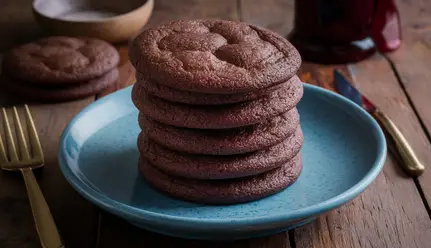Introduction
Baking is as much a science as it is an art. When it comes to making the perfect brownie cookies, achieving the right texture is crucial. The perfect brownie cookie should have a soft and fudgy center with a slightly crisp edge. However, one of the most common issues bakers face is ending up with flat brownie cookies that lack the desired thickness and chewiness. If you’ve ever asked yourself, “Why are my brownie cookies flat?” you’re not alone. In this article, we’ll explore the various factors that could be causing this problem and how to fix it.
Understanding the Basics of Brownie Cookies
Before we dive into the reasons why your brownie cookies might be coming out flat, it’s important to understand the basics of what makes these cookies unique. Brownie cookies are a hybrid between brownies and cookies, combining the best of both worlds. They should have the rich, chocolatey flavor and dense texture of a brownie while maintaining the shape and structure of a cookie.
Achieving this balance requires attention to detail at every step of the baking process, from the ingredients you use to the way you mix the batter and bake the cookies. Small deviations in these steps can lead to cookies that spread too much in the oven, resulting in a flat, pancake-like appearance.
Common Reasons Why Brownie Cookies Turn Out Flat
1. Incorrect Measurement of Ingredients
One of the most common reasons for flat brownie cookies is incorrect measurement of ingredients. Baking is a science, and even small variations in ingredient quantities can affect the final outcome.
- Too much sugar: Sugar attracts moisture and can cause cookies to spread too much in the oven, leading to a flat appearance.
- Too much butter or oil: Fats also contribute to spreading. If your recipe calls for melted butter or oil, be cautious not to overdo it. The ratio of fat to flour needs to be precise to maintain the cookie’s structure.
- Not enough flour: Flour provides the structure for your cookies. If you don’t use enough, your cookies may not have enough substance to hold their shape.
Solution: Always measure your ingredients carefully using a kitchen scale. If you’re using cups, make sure to spoon the flour into the measuring cup and level it off with a knife to avoid packing in too much or too little.
2. Overmixing the Dough
Overmixing the dough is another common mistake that can result in flat cookies. When you overmix, you incorporate too much air into the dough, which causes the cookies to rise excessively in the oven and then collapse as they cool, leading to a flat and dense cookie.
Solution: Mix the dough just until the ingredients are combined. If you’re using an electric mixer, use a low speed and be cautious not to overwork the dough. The less you mix, the better the cookies will hold their shape.
3. Using Warm Ingredients
Using warm ingredients, especially melted butter, can cause your cookies to spread too quickly in the oven. This is because the warmth causes the fat to melt faster, leading to a thinner cookie that doesn’t have time to set and rise properly.
Solution: Allow melted butter to cool slightly before adding it to your dough. If a recipe calls for room temperature eggs, ensure they’re not too warm. If necessary, you can chill the dough for 15-30 minutes before baking to help the cookies maintain their shape.
4. Baking at the Wrong Temperature
The oven temperature plays a critical role in how your cookies bake. If the oven is too hot, the butter or oil in the dough will melt too quickly, causing the cookies to spread out before they have a chance to set. Conversely, if the oven is too cool, the cookies might not spread enough, but they will still flatten out as they bake.
Solution: Always preheat your oven to the temperature specified in the recipe. Use an oven thermometer to check that your oven is accurate. If you notice your cookies are consistently flat, try baking at a slightly lower temperature to give the cookies more time to rise and set before spreading out.
5. Not Using Enough Leavening Agent
Leavening agents like baking powder and baking soda are essential for giving your cookies the right lift. If you don’t use enough, or if your leavening agents are old and have lost their potency, your cookies might not rise properly, leading to a flat result.
Solution: Make sure you are using the correct amount of leavening agent as specified in your recipe. Check the expiration dates on your baking powder and baking soda, and replace them if they are outdated.
6. Overcrowding the Baking Sheet
Overcrowding the baking sheet is another factor that can lead to flat cookies. When cookies are placed too close together, they don’t have enough room to spread properly and can end up merging together. This can prevent the edges from setting correctly, causing the cookies to spread out more than they should.
Solution: Leave at least two inches of space between each cookie on the baking sheet. If necessary, bake in batches rather than trying to fit all the cookies on one sheet.
7. Incorrect Baking Sheet
The type of baking sheet you use can also impact how your cookies turn out. Dark-colored baking sheets absorb more heat and can cause the bottoms of your cookies to bake faster, leading to spreading. Similarly, thin baking sheets can cause uneven heat distribution, affecting how the cookies rise.
Solution: Use a light-colored, heavy-duty baking sheet for the most even baking results. Lining your baking sheet with parchment paper or a silicone baking mat can also help prevent the cookies from spreading too much.
Troubleshooting Tips for Flat Brownie Cookies
If you’ve tried all the above suggestions and your brownie cookies are still coming out flat, don’t despair! Here are a few additional troubleshooting tips to help you achieve the perfect cookie.
Adjust the Recipe
Sometimes, small tweaks to the recipe can make a big difference. For example, you might try:
- Increasing the flour: Add an extra tablespoon or two of flour to help the cookies hold their shape.
- Reducing the sugar: Cut back on the sugar by a tablespoon to prevent excessive spreading.
- Chilling the dough: Chilling the dough for 30 minutes to an hour before baking can help control the spread.
Experiment with Oven Temperature
If your cookies are consistently flat, try lowering the oven temperature by 10-15 degrees Fahrenheit. This will slow down the spreading process and give the cookies more time to rise and set before they flatten out.
Use a Different Type of Fat
If your recipe calls for melted butter and you’re struggling with flat cookies, try using softened butter instead. Softened butter will cream with the sugar better, creating more air pockets and helping the cookies rise. Alternatively, try using half butter and half shortening to get the benefits of both fats.
Add More Leavening
If you suspect your cookies aren’t rising enough, try adding a little extra baking powder or baking soda. Be careful not to overdo it, though, as too much leavening can cause cookies to rise too quickly and then collapse.

The Science Behind Cookie Spread
Understanding the science behind why cookies spread can help you troubleshoot flat brownie cookies more effectively. Here’s a brief overview:
- Fat Content: The type and amount of fat used in a recipe have a significant impact on how much cookies spread. Butter, for instance, has a lower melting point than shortening, causing cookies to spread more. Adjusting the fat ratio can help control the spread.
- Sugar Type: The type of sugar used can also influence spreading. Granulated sugar causes more spread than brown sugar, which contains molasses and adds moisture, leading to a chewier cookie.
- Eggs: Eggs provide structure and moisture to cookies. If a recipe calls for one egg and you’re getting flat cookies, try adding an extra egg yolk to increase the richness and structure.
- Mixing Method: How you mix your dough affects the amount of air incorporated, which in turn affects how much your cookies spread. Creaming butter and sugar together creates air pockets, leading to a lighter, fluffier cookie.
Variations and Alternatives to Consider
If you’re consistently having trouble with flat brownie cookies, you might consider experimenting with different recipes or techniques. Here are a few ideas:
- Brownie Cookie Bars: If you’re struggling with flat cookies, consider turning your brownie cookie recipe into bars. Bake the dough in a pan instead of scooping it into individual cookies. This method can help ensure a thicker, chewier result.
- Thick and Chewy Brownie Cookies: Look for recipes specifically designed to produce thick and chewy cookies. These recipes often use more flour, less sugar, or a combination of different fats to achieve the desired texture.
- Double Chocolate Brownie Cookies: Adding extra chocolate, either in the form of chunks or chips, can help bulk up the dough and prevent spreading. The extra chocolate also adds richness and improves the overall flavor.
The Role of Ingredients: A Closer Look
To further understand why your brownie cookies might be flat, let’s take a closer look at the role of key ingredients:
Butter
Butter is a critical ingredient in cookie recipes, contributing to flavor, texture, and spread. The water content in butter turns to steam during baking, creating air pockets that help cookies rise. However, if the butter is too warm or melted, it can cause excessive spreading.
Sugar
Sugar not only sweetens the dough but also influences the cookie’s texture. Granulated sugar encourages spreading, while brown sugar, which contains molasses, adds moisture and chewiness, helping to reduce spreading.
Eggs
Eggs act as a binder in cookie dough, providing structure and moisture. They also help the dough rise during baking. If a recipe lacks enough eggs or uses only egg whites, the cookies might spread too much.
Flour
Flour provides the structure for your cookies. The type of flour and how much you use can greatly affect the texture. All-purpose flour is standard, but using bread flour can result in a chewier cookie, while cake flour will produce a more tender, less chewy cookie.
Conclusion: Perfecting Your Brownie Cookies
Achieving the perfect brownie cookie is a delicate balance of ingredients, technique, and baking time. If your brownie cookies are turning out flat, it could be due to a variety of factors, from ingredient measurements to oven temperature. By paying close attention to each step of the process and making small adjustments as needed, you can troubleshoot the issue and enjoy thick, chewy, and delicious brownie cookies every time.
Remember, baking is both an art and a science, and it might take a few tries to get it just right. But with patience and practice, you’ll be able to bake the perfect brownie cookies that will impress everyone who tastes them.

